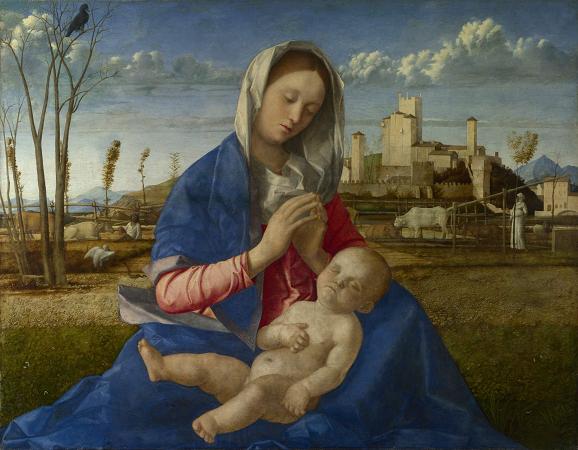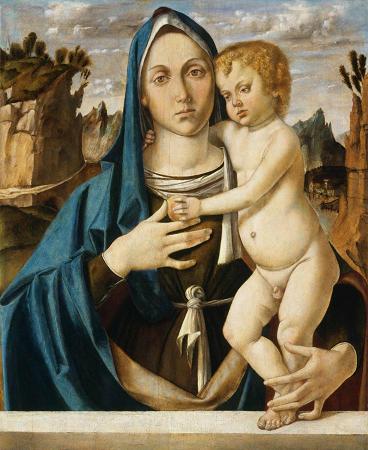Bartolomeo Montagna (c1450 - 1523). Bartolomeo Montagna was an Italian Renaissance painter who mainly worked in Vicenza. He also produced works in Venice, Verona, and Padua. He is most famous for his many Madonnas and his works are known for their soft figures and depiction of eccentric marble architecture. He is considered to be heavily influenced by Giovanni Bellini, in whose workshop he might have worked around 1470. Benedetto Montagna, a productive engraver, was his son and pupil and active until about 1540. He was mentioned in Vasari's Lives as a student of Andrea Mantegna but this is widely contested by art historians. He was born Bartolomeo Cincani and later changed his name to Bartolomeo Montagna. The first known written record of his existence is from 1459 and list him as a minor. The first known documentation of him as an adult is in 1480 as a witness of a will. Differences in two documents regarding his father's property from 1467 and 1469 imply he became an adult between those two years. Because of the lack of formal documentation of his birth and confusion on the age of legal adulthood in Vicenza at that time, there is much debate as to his actual birthdate. Some scholars have agreed on close to 1450 while others place him closer to 1453-1454. His family originated in Brescia, Italy and later moved to Biron around 1450 before settling in Vicenza sometime by 1460. His brother, Baldissera, was a goldsmith. For most of his life through his death he was a resident of Vicenza and lived in a house he purchased directly across from the Church of San Lorenzo in 1484. From 1469-1475 Montagna was in Venice before returning to Vicenza and starting his career as a painter. In 1509, he moved from Vicenza to Padua likely due to the war in Vicenza, and remained there until 1514. The identity of his wife is unknown, but they had three sons. One of his sons, Benedetto Montagna, was also an artist famous for his engravings. His other two sons, Filippo and Paolo are mentioned in some contracts but absent from his will. Bartolomeo Montagna died on October 11, 1523. He left the majority of his possessions and his practice to his son, Benedetto. Because the birthdate of Montagna is unknown, there is also debate as to when exactly he began his career and how old he was at the time. Throughout his career, his works are characterized by a simple, laconic nature. His figures often appear solemn and plastic in form. His first known documented commission was for two paintings for the Scuola Grande di San Marco in Venice. The paintings were contracted to depict the Deluge and another scene from Genesis, however their final status is unknown as they were destroyed in a fire in 1485. The next known record of Montagna's work is for an altarpiece in the hospital of Vicenza, of which the current whereabouts are also unknown. His first extant painting is from September 1487 for a painting of The Virgin and Child with Saint Sebastian and Roch. A small work intended for private use, it depicts the figures in a marble enclosure with a Vicentine landscape in the background. This painting also shows Montagna's first known use of trachyte marble, a unique texture of marble, which is seen in most of his works. Around this time, he was also commissioned to do the high altarpiece of San Bartolomeo of Vicenza, of which the exact date is often debated. This shows influences from multiple works of Giovanni Bellini located Venice that are also undated. In 1490 he painted an altarpiece for the Certosa di Pavia showing the Virgin and Child Enthroned with Saint John the Baptist and Jerome. In 1491 he painted the altarpiece, the semi-dome, and other wall frescos for the oratory dedicated to St. Blaise at the church of Santi Nazaro e Celso in Verona. The semidome depicts St. Blaise with companions and the walls depict other scenes from the legends of St. Blaise. These works are noted for their realistic gaunt figures. From 1497-1499 he was paid monthly to work on an altarpiece for the Squarzi family. His final payment was in the form of a piece of property which he kept until 1503. This was located in a chapel in the Church of San Michele and entitled Madonna and Child Enthroned with Saints. The outlines of this painting are very bold compared to his other works and it features detailed drapery. His early works are generally characterized by the use of trachyte marble architecture and a particular positioning of the Virgin's hand, showing the middle and ring-finger touching and widely separated from the index and pinky finger. They also are usually distinguished by their symmetry, organization, equally distributed light, and plastic-like quality to the figures.
more...











